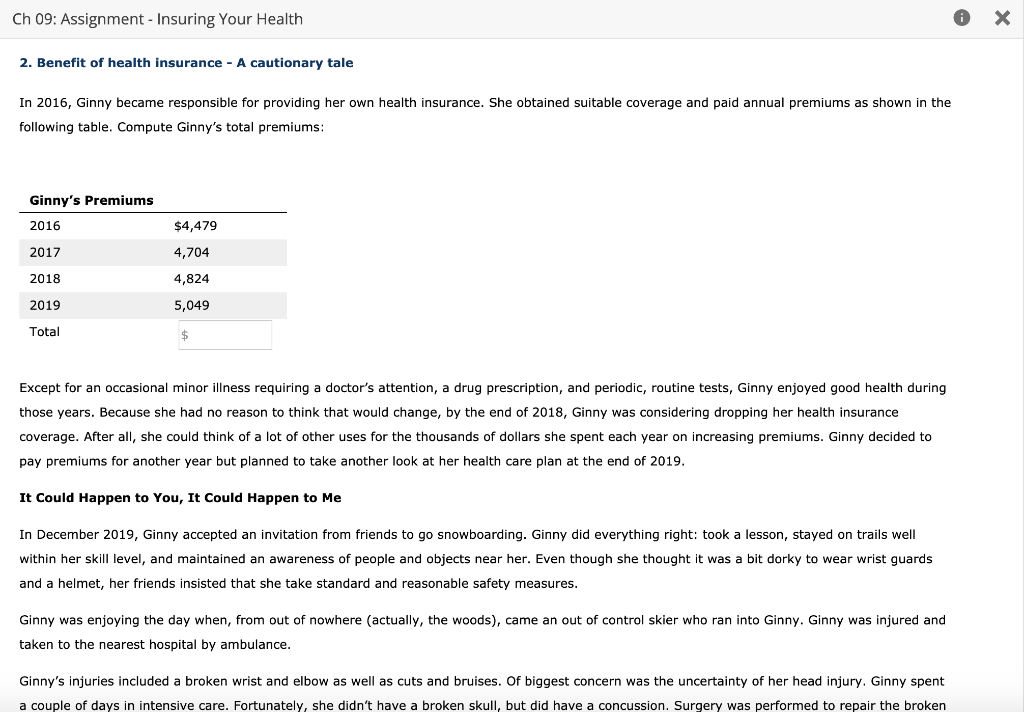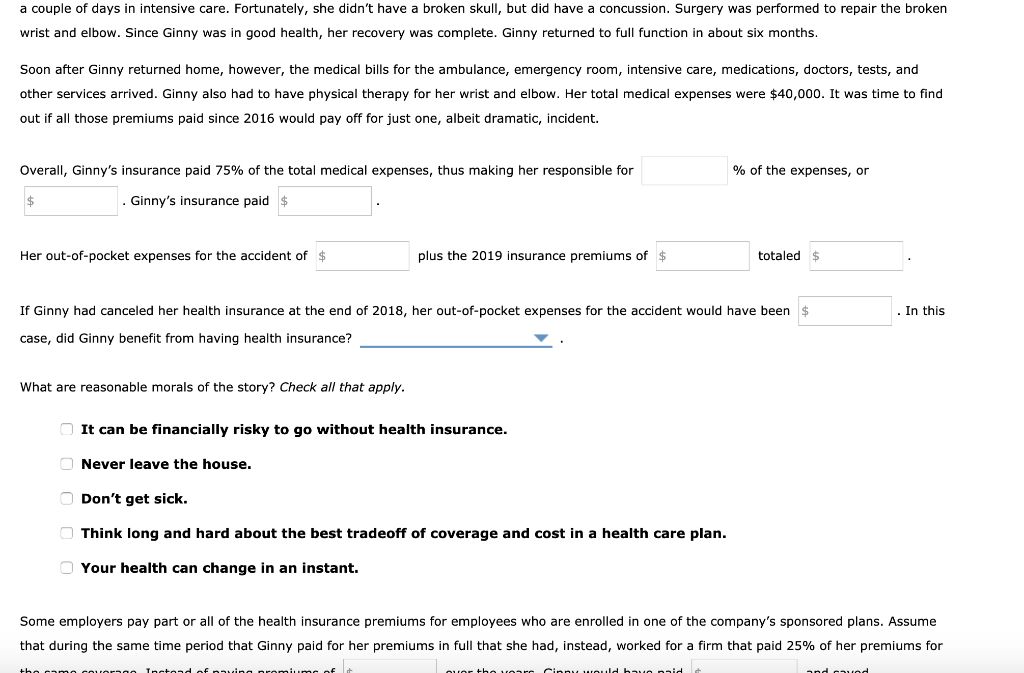Answered step by step
Verified Expert Solution
Question
1 Approved Answer
Options for the first drop-down: a) Neither, she broke even. b) No. c) Yes. Options for drop-down 2: a) More than. b) The same as.


 Options for the first drop-down: a) Neither, she broke even. b) No. c) Yes.
Options for the first drop-down: a) Neither, she broke even. b) No. c) Yes.
Options for drop-down 2: a) More than. b) The same as. c) Less than.
Options for the last drop-down: a) The more premium her employer pays, the LESS coverage there is. b) The more premium her employer pays, the MORE coverage there is. c) Her employer only contributes to premiums.
Ch 09: Assignment - Insuring Your Health X 2. Benefit of health insurance - A cautionary tale In 2016, Ginny became responsible for providing her own health insurance. She obtained suitable coverage and paid annual premiums as shown in the following table. Compute Ginny's total premiums: Ginny's Premiums 2016 $4,479 2017 4,704 2018 4,824 2019 5,049 Total Except for an occasional minor illness requiring a doctor's attention, a drug prescription, and periodic, routine tests, Ginny enjoyed good health during those years. Because she had no reason to think that would change, by the end of 2018, Ginny was considering dropping her health insurance coverage. After all, she could think of a lot of other uses for the thousands of dollars she spent each year on increasing premiums. Ginny decided to pay premiums for another year but planned to take another look at her health care plan at the end of 2019. It Could Happen to You, It Could Happen to Me In December 2019, Ginny accepted an invitation from friends to go snowboarding. Ginny did everything right: took a lesson, stayed on trails well within her skill level, and maintained an awareness of people and objects near her. Even though she thought it was a bit dorky to wear wrist guards and a helmet, her friends insisted that she take standard and reasonable safety measures. Ginny was enjoying the day when, from out of nowhere (actually, the woods), came an out of control skier who ran into Ginny. Ginny was injured and taken to the nearest hospital by ambulance. Ginny's injuries included a broken wrist and elbow as well as cuts and bruises. Of biggest concern was the uncertainty of her head injury. Ginny spent a couple of days in intensive care. Fortunately, she didn't have a broken skull, but did have a concussion. Surgery was performed to repair the broken a couple of days in intensive care. Fortunately, she didn't have a broken skull, but did have a concussion. Surgery was performed to repair the broken wrist and elbow. Since Ginny was in good health, her recovery was complete. Ginny returned to full function in about six months. Soon after Ginny returned home, however, the medical bills for the ambulance, emergency room, intensive care, medications, doctors, tests, and other services arrived. Ginny also had to have physical therapy for her wrist and elbow. Her total medical expenses were $40,000. It was time to find out if all those premiums paid since 2016 would pay off for just one, albeit dramatic, incident. Overall, Ginny's insurance paid 75% of the total medical expenses, thus making her responsible for % of the expenses, or $ . Ginny's insurance paid $ Her out-of-pocket expenses for the accident of $ plus the 2019 insurance premiums of $ totaled $ . In this If Ginny had canceled her health insurance at the end of 2018, her out-of-pocket expenses for the accident would have been case, did Ginny benefit from having health insurance? What are reasonable morals of the story? Check all that apply. It can be financially risky to go without health insurance. Never leave the house. Don't get sick. Think long and hard about the best tradeoff of coverage and cost in a health care plan. Your health can change in an instant. Some employers pay part or all of the health insurance premiums for employees who are enrolled in one of the company's sponsored plans. Assume that during the same time period that Ginny paid for her premiums in full that she had, instead, worked for a firm that paid 25% of her premiums for would bambid and und Some employers pay part or all of the health insurance premiums for employees who are enrolled in one of the company's sponsored plans. Assume that during the same time period that Ginny paid for her premiums in full that she had, instead, worked for a firm that paid 25% of her premiums for the same coverage. Instead of paying premiums of $ over the years, Ginny would have paid $ and saved In this case, Ginny's out-of-pocket expenses specific to her snowboarding accident would have been they actually were becauseStep by Step Solution
There are 3 Steps involved in it
Step: 1

Get Instant Access to Expert-Tailored Solutions
See step-by-step solutions with expert insights and AI powered tools for academic success
Step: 2

Step: 3

Ace Your Homework with AI
Get the answers you need in no time with our AI-driven, step-by-step assistance
Get Started


